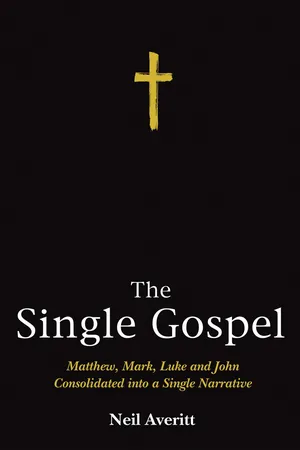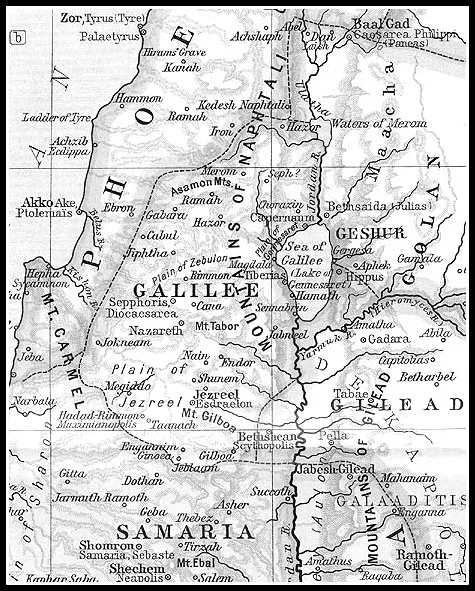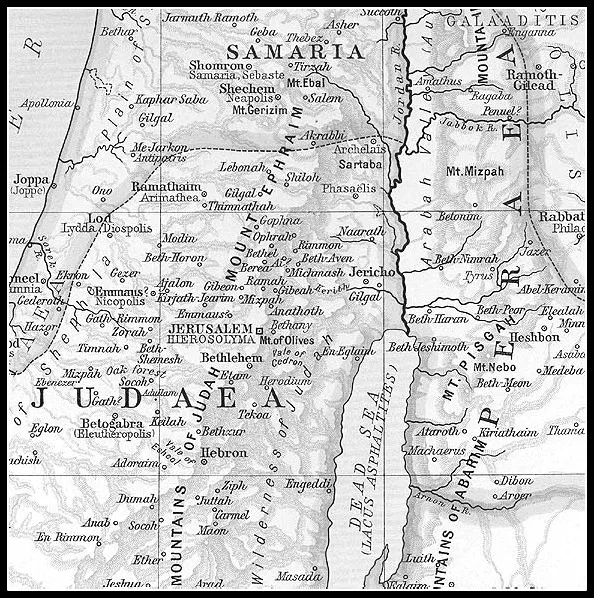![]()
Appendix 1
Maps
Galilee
From the Historical Atlas, by William R. Shepherd (1911)
Judea
From the Historical Atlas, by William R. Shepherd (1911)
![]()
Appendix 2
Principles of Composition
This note will explain the general methodology that was used in assembling the text of this volume. Two sets of issues had to be considered during the writing process. One task was to find the best way of meshing the four gospels so as to create the most readable and illuminating single narrative. This was the work of harmonizing, and it was to some degree a technical matter of understanding the substance and the sequencing of the original texts. The second task was finding the best form of words to express this harmonized text. This was the task of translating, and it proved to be more an art than a science. It called for continuing efforts to maintain the right tone of language, and also to preserve particular phrases from older translations that have become a familiar part of Christian literature.
The discussion below will explain how I have approached these two tasks. This discussion will begin with first the general and then the specific issue of harmonization; and afterwards it will turn to the general and specific issues involved in the translation.
The general approach to harmonizing
The process of rearranging material, which is at the heart of this harmony, has taken three broad forms.
The first, and simplest, involves sequencing entire chapters of the gospels. Some incidents are recounted by one and only one of the gospel writers. For example, Luke describes Christ’s birth at Bethlehem, and the announcement of that event to the shepherds in the nearby fields. Matthew describes the gifts of the Magi, the anger of King Herod, and the flight into Egypt. These varied incidents can be arranged into chronological order without any further internal editing.
In other situations, an incident is described by several of the gospel writers, and each one contributes some extended passage about it. In those cases the relevant passages can be handled in units of whole sentences, and the sentences put into a sequence that makes for a sensible presentation. For example, in the description of the Great Commission to preach the gospel, Matthew reports that the disciples are to baptize all nations in the name of the Father, the Son, and the Holy Spirit. Mark reports that those who believe and are baptized will be saved. These reports can be combined in one description of Jesus’ instructions. This merely requires some care to put the sentences into the most relevant order.
Finally, the most challenging situation arises when the accounts of the different gospels must be interwoven on a word-by-word basis. This situation comes up when the different accounts each provide some unique details of a single event. A good example of this is the account of the Holy Spirit descending on Jesus in the form of a dove, as discussed in the Introduction.
In selecting the passages for the harmony I have favored a general policy of inclusiveness. This has meant preserving certain familiar and well established passages, even if they are based on Greek texts now believed to have been altered or added at a later time. These questioned passages include such familiar material as the angel stirring the waters at Bethesda; the last twelve verses of Mark; and the incident of the woman taken in adultery. Although this material may not date to the very earliest manuscripts, some of it still dates to the early days of the church, and may reflect a recording of oral traditions dating back to the time of Jesus. I have taken the view that these important passages, plus a number of shorter phrases, even if not resting on the most original textual basis, have acquired their own legitimacy through their long and widespread acceptance by the Christian community. Moreover, the goal of this book is to include all the material that has been important to one or another group of Christian believers over the centuries. I have identified in footnote the principal passages that have been disputed.
Some specific issues in the harmonization
The process of combining or eliminating passages will require, of course, innumerable editorial judgments. One recurring question is when a series of descriptions from different gospels are indeed “unique facts,” and when they instead overlap to such an extent that some should be dropped, even when they are not precisely the same words. This poses difficult choices, because every word has some individual connotations, but too much redundancy will make the narrative unreadable. For example, the crowd that witnessed the healing of the paralytic on the mat was variously described as “amazed” (Mark 2:12), “filled with fear” (Luke 5:26), and “awestruck” (Matthew 9:8). While this was not an easy call, I decided that the concept of being “filled with fear” was included within the broader and related term for being “filled with awe,” and I therefore did not keep it as a separate description.
The harmonized text also reflects a few other editorial judgments that were made for the sake of a more complete and readable story.
First, I have included sixteen additional verses from the first two chapters of the book of Acts, which provide further details about the last days of Jesus’ time on earth, and the coming of the Holy Spirit at Pentecost. Acts is generally believed to be a continuation of Luke, by the same author, and so these additions seem to be legitimately of a piece with the other gospel accounts. With a similar goal of completing the story I have also included four short verses from 1 Corinthians, which contain direct quotes from Jesus and other essential details.
A more difficult issue is posed by the middle sections of Luke. The narrative there describes some of the same incidents as in the other gospel accounts, but in a different time sequence. If these were all treated as separate incidents in the combined narrative, it would result in jarring repetition. In some cases similar things may have happened twice, of course. Jesus surely repeated his key teachings with different audiences. In other cases, however, it is likely that Luke was simply not following a rigid chronology. I have therefore made some editorial distinctions. I have retained the repetitions where Jesus may have returned to an important point in different teaching contexts. But I have consolidated the accounts where an entire extended scene is repeated in two places—for example, the “Woe to the Pharisees” speech or Jesus’ denial of an alliance with Beelzebub—or where a shorter saying is repeated in circumstances where it is not obviously essential both times.
There have been many guides in the preparation of this book. Concordances and harmonies of the gospels have been prepared for virtually the entire life of the Church. One of the most useful recent ones has been Orville Daniel’s scholarly and thoughtful book, A Harmony of the Four Gospels. That presents the four gospels in four parallel columns, coordinated chronologically, and highlights the passages that are unique to each account. Two other essential guides have been Ralph Heim’s book, A Harmony of the Gospels, which presents the accounts in parallel columns using the Revised Standard translation, and Thomas Mumford, Horizontal Harmony of the Four Gospels in Parallel Columns, which uses the King James Version. Other harmonies have also been helpful in the writing here.
The present harmony is nonetheless different from its predecessors in crucial respects. Most notably, most earlier versions were committed to preserving the entire text of each of the four gospels, and they therefore set out all that material in separate columns. While this approach is excellent for students of theology and other professional users, it makes for difficult reading and a repetitive narrative. A few other harmonies do aim for a single integrated text, but these have generally involved rearrangements of the material from one standard translation only. This approach has the virtue of fidelity to a recognized account, but it leaves the reader with awkward seams and transitions.
The present book has adopted a different approach, and has made a full consolidation of the material into one story, and at the same time using new wording that smooths out the seams into a continuous narrative.
To help the reader keep track of this long and single story, I have divided the account into chapters—each under a descriptive title—recounting particular themes or events. The chapter titles are added for clarity and are not part of the original texts. Another clarifying device has been the division of each chapter into verses. These correspond to paragraphs marking the distinct segments or turning points in the account, and make it easier for the reader to follow the stages of the story. The division of verses is again my own, and is also not biblical. While I have generally followed the punctuation of earlier translations, I have felt free to alter that when it seemed to permit greater clarity.
The layout of the book will let the reader see where the material came from, and what editing decisions have been made. Directly beneath the title of each chapter is a list of the passages in the original gospels from which the material was taken. The specific edits in that material are generally not separately identified. This harmony makes so many deletions of overlaps, and so many shifts between the four gospels, that those could not be individually marked without unduly cluttering the text. Because the underlying source material is identified, the reader can easily go to the original texts if desired.
One particularly important type of edit is explicitly marked, however. Sometimes I have added words of my own. In these cases the added words are distinctively printed in italics. This is most commonly done when a transition is needed between passages that are newly brought together. Inserts in that situation can help the reader keep track of the time or place involved, such as “Back in Jerusalem . . . .,” or “When Jesus returned from the wilderness . . . .” Less commonly they will help to clarify a situation where different gospels might have pointed in different directions. Because Matthew and Luke focus on describing different aspects of the preparations for the Sermon on the Mount, for example, there may be some question of whether the sermon was addressed just to the disciples or to a larger crowd. An insert here clarifies that both groups were in Jesus’ audience, and that “his voice also carried to the crowd below.”
The general approach to translation
This harmony is also presented in a new translation. At first glance this may seem surprising, given that the Bible is already the most-translated work of all time. But there are two good reasons for a new text here.
The first is the need to make the substantive harmonization work well. The process of preparing the harmony has rearranged the gospel material, and a simple cut-and-paste will not necessarily produce a smooth text. The most appropriate English word to use in a translation will often depend on its context, and the contexts here are sometimes new as a result of movements of the text. Hence some phraseology is...


